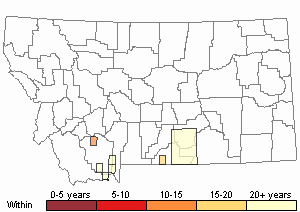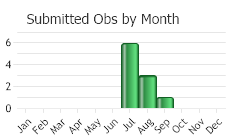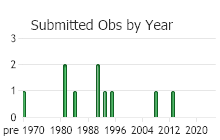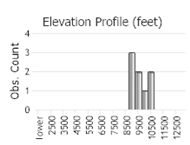View in other NatureServe Network Field Guides
NatureServe
Montana
Utah
Wyoming
Idaho
Wisconsin
British Columbia
South Carolina
Yukon
California
New York
Round-fruited Draba - Draba globosa
Other Names:
Draba apiculata
State Rank Reason (see State Rank above)
Round-fruited draba is a regional endemic, known from widely separated sites in Colorado, northeastern Utah, northwest Wyoming and adjacent Montana. It has been found in three southwest Montana mountain ranges. Current population levels and trends are unknown. However, its high-elevation habitat is relatively inaccessible, and there are no obvious threats. Additional sites are likely to be documented.
- Details on Status Ranking and Review
Population Size
Score2 - Small: Generally 2,000-10,000 individuals.
Range Extent
Score1 - Peripheral, Disjunct or Sporadic Distribution in MT: Widespread species that is peripheral, disjunct or sporadically distributed within MT such that it occurs in <5% of the state (<7,500 sq. miles or the combined area of Beaverhead and Ravalli Counties) or is restricted to 4-5 sub-basins.
Area of Occupancy
Score2 - Low: Generally occurring in 4-10 Subwatersheds (6th Code HUC’s).
Environmental Specificity
Score1-2 - Moderate to High.
Trends
Score0-1 - Stable to Minor Declines:
CommentTrends unknown, though populations are likely stable or experiencing only minor declines.
Threats
Score0-1 - Low to Medium.
CommentHabitat is remote.
Intrinsic Vulnerability
Score1 - Moderate Vulnerability: Specific biological attributes, unusual life history characteristics or limited reproductive potential makes the species susceptible to extirpation from stochastic events or other adverse impacts to its habitat and slow to recover.
Raw Conservation Status Score
Score
7 to 10 total points scored out of a possible 19.
General Description
Round-fruited Draba is a small, stemless, herbaceous perennial, which forms cushions that are up to 20 cm wide and which consist of basal leaf rosettes that arise from a branched rootcrown. The lance-shaped to narrowly spoon-shaped leaves are 3-6 mm long and have a few stiff marginal hairs but are otherwise glabrous. 2-10 small yellow or sometimes white flowers are borne on top of a stalk that reaches up to 45 mm high. Each flower has 4 separate petals that are ca. 4 mm long, 4 separate sepals, and 4 long and 2 short stamens. The glabrous, compressed egg-shaped capsule, or silicle, is 3-8 mm long with a style projecting 0.2-0.7 mm from the tip.
Phenology
Flowering and fruiting occur in July.
Diagnostic Characteristics
Draba is a genus of many similar-appearing species. In Montana, Draba globosa, D. densifoliaand D. daviesiae are the only species with yellow flowers and leaves that are glabrous above but with ciliate margins. Draba densifolia has pubescent fruits, while those of D. globosa and D. daviesiae are glabrous. Of the latter two, D. globosa has pointed leaves with 2-5 flowers, while D. daviesiae has rounded leaves and 5-10 flowers.
Species Range
Montana Range
Range Descriptions

 Native
Native
Range Comments
Regional endemic of southwestern Montana, central Colorado, northern Utah and western and southern Wyoming.
Observations in Montana Natural Heritage Program Database
Number of Observations: 10
(Click on the following maps and charts to see full sized version)
Map Help and Descriptions
Relative Density

Recency



 (Observations spanning multiple months or years are excluded from time charts)
(Observations spanning multiple months or years are excluded from time charts)
Habitat
In Montana round-fruited draba has been found in the Madison and Centennial ranges, where it grows in moist, sparsely vegetated, often calcareous soil of moraine and fellfields, near or above treeline from 9,500 to 10,500 feet in elevation. Associates include Silene acaulis, Ranunculus eschscholtzii, Phlox pulvinata and Sibaldia procumbens.
Ecological Systems Associated with this Species
- Commonly Associated with these Ecological Systems
Alpine Systems
Management
Draba globosa is found in inaccessible high-elevation sites, often in wilderness areas. There are no obvious threats to this species.
Threats or Limiting Factors
STATE THREAT SCORE REASON
Threat impact not assigned because threats are not known (MTNHP Threat Assessment 2021).
References
- Additional ReferencesLegend:
 View Online Publication
View Online Publication
Do you know of a citation we're missing? Aho, Ken Andrew. 2006. Alpine and Cliff Ecosystems in the North-Central Rocky Mountains. Ph.D. Dissertation. Bozeman, Montana: Montana State University. 343 p.
Aho, Ken Andrew. 2006. Alpine and Cliff Ecosystems in the North-Central Rocky Mountains. Ph.D. Dissertation. Bozeman, Montana: Montana State University. 343 p. Lesica, P., M.T. Lavin, and P.F. Stickney. 2012. Manual of Montana Vascular Plants. Fort Worth, TX: BRIT Press. viii + 771 p.
Lesica, P., M.T. Lavin, and P.F. Stickney. 2012. Manual of Montana Vascular Plants. Fort Worth, TX: BRIT Press. viii + 771 p. Lesica, P., M.T. Lavin, and P.F. Stickney. 2022. Manual of Montana Vascular Plants, Second Edition. Fort Worth, TX: BRIT Press. viii + 779 p.
Lesica, P., M.T. Lavin, and P.F. Stickney. 2022. Manual of Montana Vascular Plants, Second Edition. Fort Worth, TX: BRIT Press. viii + 779 p.
- Web Search Engines for Articles on "Round-fruited Draba"





